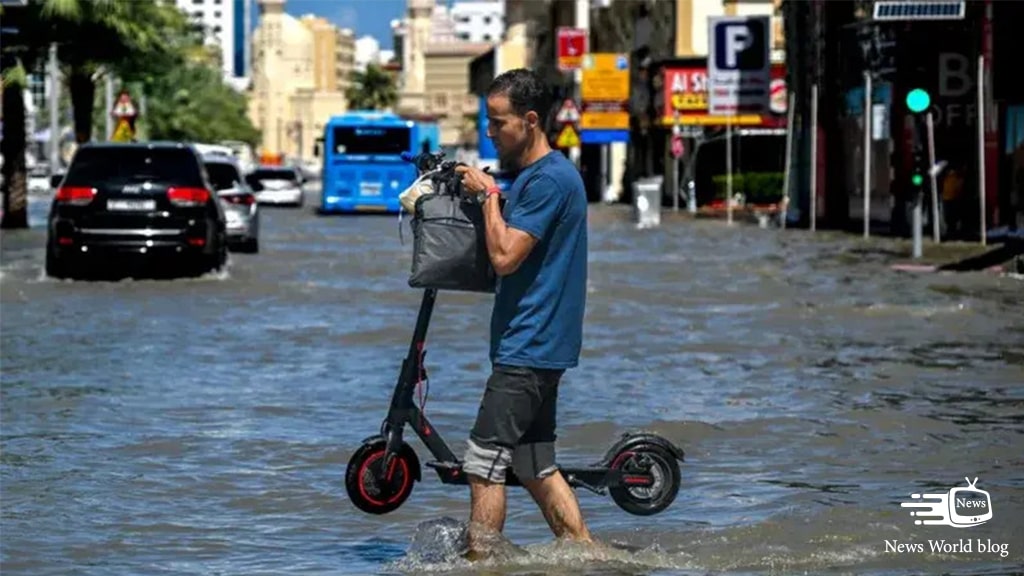Dubai has recently been hit by record-breaking floods, causing confusion and speculation about the role of cloud seeding in the event. This article dives into the unusual rainfall, the causes behind the extreme downpours, and the impact of cloud seeding.
Extreme Rainfall in Dubai
Dubai, located on the coast of the United Arab Emirates (UAE), is known for its arid climate with average annual rainfall below 100mm (3.9in). However, the city recently experienced a 24-hour period with a staggering 256mm (10in) of rain recorded in Al-Ain, just over 100km from Dubai.
The culprit behind this extreme weather event was a “cut off” low pressure system. This system drew in warm, moist air and blocked other weather systems, leading to the intense downpours.
Climate Change and Rainfall
While a full scientific analysis is needed to pinpoint the exact influence of climate change, the record rainfall aligns with current climate trends. Warmer air holds more moisture, roughly 7% extra per degree Celsius, which can intensify rainfall.
Experts like Professor Richard Allan from the University of Reading emphasize that the record-breaking intensity of the rain is consistent with a warming climate. This warming creates a scenario where storms have access to more moisture, leading to more potent and consequential floods.
A recent study suggests that annual rainfall across the UAE could increase by up to 30% by the end of the century as global temperatures continue to rise. Dr. Friederike Otto, a senior lecturer in climate science at Imperial College London, highlights the dangers of inaction, stating that continued reliance on fossil fuels will exacerbate climate change, leading to heavier rainfall and more devastating floods.
Cloud Seeding: Did it Play a Role?
Cloud seeding is a technique that manipulates existing clouds to produce more rain. This is achieved by dispersing small particles, like silver iodide, into clouds via aircraft. These particles act as catalysts, allowing water vapor to condense more easily and form rain.
The UAE has employed cloud seeding in recent years to address water scarcity issues. Following the floods, some social media reports incorrectly attributed the extreme weather solely to cloud seeding.
Experts debunk this claim. While cloud seeding operations might have taken place earlier in the week, their impact on the storm would have been minimal at best. Dr. Otto points out that even if cloud seeding did influence rain around Dubai, the abundance of moisture in the atmosphere, likely a result of climate change, would have played a more significant role.
Cloud seeding is typically used when conditions like wind, moisture, and dust are insufficient for natural rain formation. Interestingly, meteorologists had already predicted a high risk of flooding across the Gulf region in the days leading up to the event.
Professor Diana Francis, head of Environmental and Geophysical Sciences at Khalifa University in Abu Dhabi, clarifies that cloud seeding is not used in large-scale, intense weather systems because it’s unnecessary and cost-prohibitive.
BBC weather meteorologist Matt Taylor confirms that weather models, which don’t account for cloud seeding, were already predicting a year’s worth of rain to fall in Dubai within a 24-hour period. He also points out that the widespread flooding across the region, impacting areas from Bahrain to Oman, is beyond the scope of what cloud seeding could achieve.
The National Center of Meteorology (NCM), a government task force, manages cloud seeding missions in the UAE.
Preparing for the Future
Mitigating the impact of heavy rainfall and preventing them from turning into deadly floods requires robust defenses against sudden and intense downpours. Dubai’s heavy urbanization presents a challenge. With limited green space to absorb moisture, the drainage systems were overwhelmed by the exceptional rainfall.
Professor Francis emphasizes the need for adaptation strategies to cope with this “new reality” of more frequent and intense rainfall. These strategies could involve adapting infrastructure, building reservoirs to store excess rainwater, and utilizing it during drier periods. The UAE’s Road and Transport Authority took a step in the right direction by establishing a new unit dedicated to flood management in Dubai earlier this year.
Sources:
- Al Jazeera (https://www.aljazeera.com/tag/weather/)
- BBC News (https://www.bbc.co.uk/news/science-environment-68839043)
- University of Reading (https://www.dailymail.co.uk/news/article-13322685/Reading-University-denies-cloud-seeding-technology-caused-Dubais-devastating-floods.html)
- National Center of Meteorology (UAE) (https://mobile.ncm.gov.ae/maps-radars/uae-radars-network?lang=en)



nmBASvYr